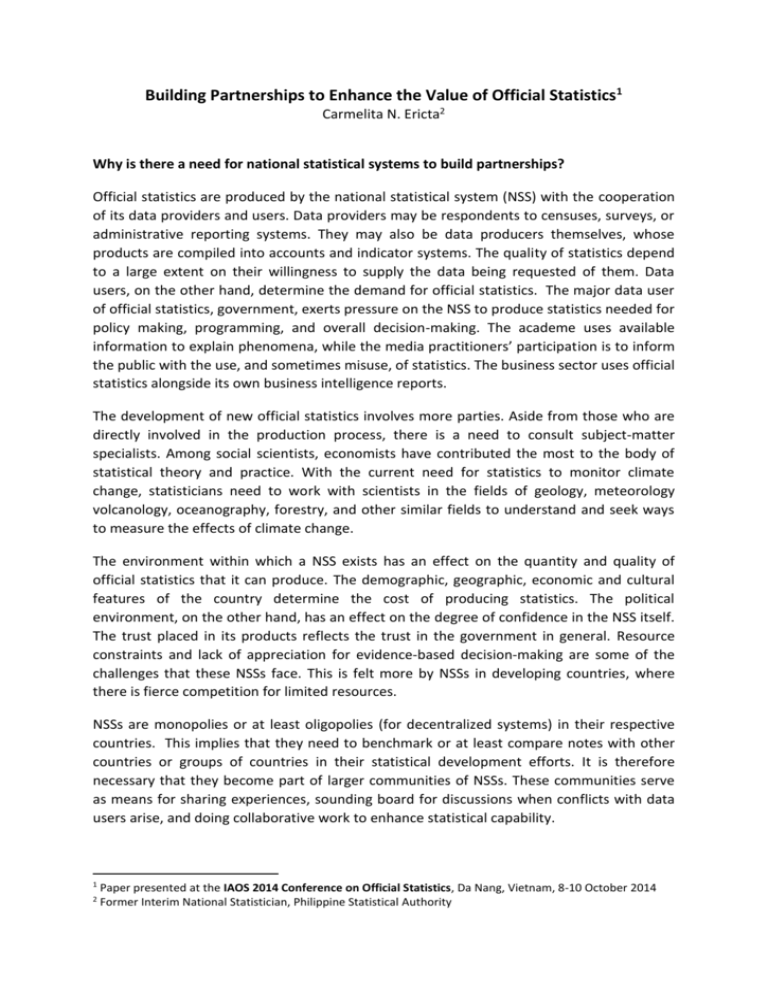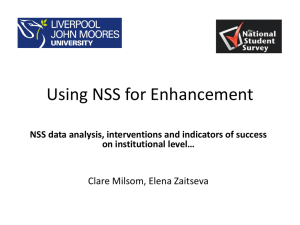Abstract - IAOS 2014 Conference
advertisement

Building Partnerships to Enhance the Value of Official Statistics1 Carmelita N. Ericta2 Why is there a need for national statistical systems to build partnerships? Official statistics are produced by the national statistical system (NSS) with the cooperation of its data providers and users. Data providers may be respondents to censuses, surveys, or administrative reporting systems. They may also be data producers themselves, whose products are compiled into accounts and indicator systems. The quality of statistics depend to a large extent on their willingness to supply the data being requested of them. Data users, on the other hand, determine the demand for official statistics. The major data user of official statistics, government, exerts pressure on the NSS to produce statistics needed for policy making, programming, and overall decision-making. The academe uses available information to explain phenomena, while the media practitioners’ participation is to inform the public with the use, and sometimes misuse, of statistics. The business sector uses official statistics alongside its own business intelligence reports. The development of new official statistics involves more parties. Aside from those who are directly involved in the production process, there is a need to consult subject-matter specialists. Among social scientists, economists have contributed the most to the body of statistical theory and practice. With the current need for statistics to monitor climate change, statisticians need to work with scientists in the fields of geology, meteorology volcanology, oceanography, forestry, and other similar fields to understand and seek ways to measure the effects of climate change. The environment within which a NSS exists has an effect on the quantity and quality of official statistics that it can produce. The demographic, geographic, economic and cultural features of the country determine the cost of producing statistics. The political environment, on the other hand, has an effect on the degree of confidence in the NSS itself. The trust placed in its products reflects the trust in the government in general. Resource constraints and lack of appreciation for evidence-based decision-making are some of the challenges that these NSSs face. This is felt more by NSSs in developing countries, where there is fierce competition for limited resources. NSSs are monopolies or at least oligopolies (for decentralized systems) in their respective countries. This implies that they need to benchmark or at least compare notes with other countries or groups of countries in their statistical development efforts. It is therefore necessary that they become part of larger communities of NSSs. These communities serve as means for sharing experiences, sounding board for discussions when conflicts with data users arise, and doing collaborative work to enhance statistical capability. 1 2 Paper presented at the IAOS 2014 Conference on Official Statistics, Da Nang, Vietnam, 8-10 October 2014 Former Interim National Statistician, Philippine Statistical Authority At the subregional level, NSSs strive for harmonization of statistics to be aligned with the integration efforts of their respective governments. A clear example of this is the joint work done by the South Pacific Community in census-taking and other major statistical activities. In the Association of South East Asian Nations (ASEAN), the NSSs are diligently working towards harmonizing their trade and economic statistics in preparation for the integration of the ASEAN Economic Community. This entails adopting comparable concepts and definitions, classification systems, and reporting protocols. A useful feature of this exercise is the so-called south-south cooperation, which the ASEAN community calls “ASEAN helps ASEAN”. The ASEAN Community Statistical System (ACSS) oversees this effort. At the regional level, NSSs share good practices, discuss common issues, conduct joint exercises towards the development of new statistical series, and in general, help one another to attain higher levels of statistical development. They are joined by regional offices of international organizations. Europe has a highly developed regional statistical system which mirrors its political integration; it has influenced not only its own member countries, but the global community as well, to adopt a number of the concepts and methodologies that it has developed as a community. The Asia-Pacific region, on the other hand, is the largest and most diverse region in terms of statistical capability. The statistical community in this region meets every two years as the Economic and Social Commission for Asia and the Pacific (ESCAP) Committee on Statistics to endorse priorities for statistical development, map out medium and long-term work programs, and share experiences and good practices. There is a conscious effort to include geographic representation in selecting the members of its councils, subcommittees and working groups. The global community of NSSs is actually the aggregate of the subregional and regional groups. It seeks to respond to demands for statistics on global concerns and international agreements. At the same time, it is where countries work together with international organizations to develop and prescribe standards for statistical development. The regional and global communities serve as excellent platforms for discussing and agreeing on priorities for developing official statistics on various concerns. However, it is really at the national and subregional levels where the collaboration results in specific positive impacts. These are the levels where commitment is measured by the provision of human and financial resources for the work to be done. Take the case of the Millennium Development Goals (MDG) monitoring. Governments agreed to set and work towards attaining those targets by a given deadline. However, the statistical community was not consulted, much less involved, in the target-setting exercise. When the NSSs were expected to provide the data for monitoring progress, they had to make do with whatever resources were made available to them. It is therefore worthwhile looking more closely into partnerships at these levels. What enables an NSS to build partnerships? The legal framework under which the NSS operates should provide it enough independence to be able to enter into agreements and commit its resources to developmental work. The stature and rank of the Chief Statistician should be such that he/she is empowered to make commitments on mobilizing resources without having to seek further ministerial approval. This is so especially when data users, including government, urgently need some sets of statistics and are willing to provide the resources needed to produce those statistics. At the same time, the technical staff should be empowered to initiate technical discussions that may lead to formal agreements among the parties concerned. This implies that there are adequate coordination mechanisms, allowing the NSS to pursue partnerships both at the policy and technical levels. Take the case of the Philippine Statistical System (PSS). Prior to the passage of the Statistics Act of 2013, the Secretary-General of the National Statistical Coordination Board (NSCB) and the Administrator of the National Statistics Office (NSO) both had the rank of Deputy Minister. The Secretary General was responsible for coordinating and managing the highly decentralized PSS. On the other hand, the Administrator was responsible for producing most of the general-purpose official statistics. The latter necessarily had the larger organization, bigger budget, and more interaction with data users and other stakeholders. As Civil Registrar General, the Administrator also enjoyed the confidence of the public, being responsible for a sensitive frontline service, and was therefore better-known. There were many instances where the situation gave rise to confusion as to who should represent the PSS in national and even international undertakings. This was one of the findings of the Special Committee to Review the PSS. The Committee recommended among others, that structural changes be made. They further drafted a bill to this effect. Republic Act 10625, whose short title was “Statistical Act of 2013”, provides for, among others, the creation of the Philippine Statistics Authority (PSA) by merging the National Statistical Coordination Board, Bureau of Agricultural Statistics, Bureau of Labor and Employment Statistics, and National Statistics Office. The PSA is now headed by a single person, the National Statistician, with the rank of Deputy Minister. The PSA shall be composed of the PSA Board; offices on sectoral statistics, censuses and technical coordination, civil registration and central support; and field statistical offices. The new law in effect redefines the PSS as a highly decentralized system with a strong coordination body with primary data production capability. In decreeing that the statistics produced by the PSA shall be the official and controlling statistics of government, the new law likewise strengthens its data production capability by prescribing stricter penalties for non-response and breach of confidentiality, and posting of statisticians in other government agencies. The latter provision is a result of benchmarking good practices among similar countries. The PSA was recognized by the Makati Business Club, a prestigious, influential group based in the Central Business District, as one of the ten best government agencies in the Philippines in 2014. I consider this as a vote of confidence in the new organization. I might add that the Statistical Act of 2013 also reorganized the research and training function of the PSS by abolishing the Statistical Research and Training Center and creating the much stronger Philippine Statistical Research and Training Institute (PSRTI). Within the context of the fundamental principles of official statistics, I believe that the NSS and the personnel comprising it should develop and be perceived by its stakeholders to have the characteristics of competence, integrity, and responsiveness. The NSS must be perceived as a trustworthy partner capable of working alongside the academe, development partners, and data users in developing statistics on emerging issues. The NSS and its components must be seen to satisfy reasonable demands of data users, including media, and at the same time be able to keep the relationship with data users at arm’s length. In the same way that the NSS respects the expertise of subject-matter specialists, potential partners must perceive the NSS to have expertise in statistical matters. As we know, competence of the NSS grows out of proper recruitment and continuous training of staff, rigorous research and development, and regular review of its performance and processes. Specialized institutions within the subregional and regional statistical communities play a major role in developing and maintaining the competence of NSSs, especially in developing countries. Integrity as a trait of the NSS highly affects public perception of the quality of its products and services. It becomes apparent when the NSS faces challenges from interested parties who have a stake in specific outcomes of statistics that it produces. To paraphrase what one of our statistical experts said, the only defense needed by the NSS when its outputs are challenged is to describe the methodology used in producing those statistics. It also connotes openness to external evaluation of its methodologies, and the fortitude to withstand pressures to “adjust” its estimates by disregarding those methodologies. Leadership example is crucial in projecting the integrity of the NSS. Responsiveness connotes a state of readiness on the part of the NSS to satisfy reasonable demands of data users. It implies the presence of competent staff, processes, and infrastructure to disseminate available products and services to various stakeholders, and political will to modify or revise its work program to accommodate emerging demands. Responsiveness may be considered as akin to being client oriented. Finally, there may be other characteristics of NSSs that would make them good partners. I hope that this paper starts a conversation on this.






